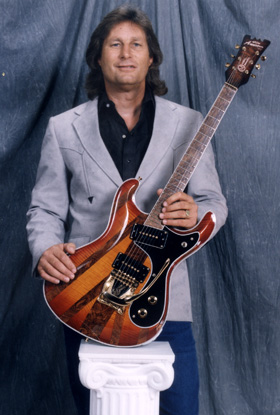

Mosrite 40th Anniversary
By Art Thompson | January, 2007
The offbeat, swooping body shape that defines Mosrite guitars was the brainchild of builder Semie Moseley—who is said to have drawn the outline of a Stratocaster body on a sheet of paper, reversed the image, and then applied his own stylistic touches to create one of the most evocative designs in electric-guitar history. Mosrites have been the choice of such stylistically diverse players as Joe Maphis, Nokie Edwards, and Johnny Ramone, and legions of other players have fallen under the spell of these hip-looking axes with skinny necks and lightning-fast playability.
Born in Durant, Oklahoma, in 1935, Moseley grew up in Bakersfield, California, after his family migrated there in 1940. It was in this dusty domain of honky-tonk country that Moseley started playing guitar in an evangelical group at age 13. Semie and his older brother, Andy, soon began refinishing and customizing guitars, and, in 1954, Semie made a radical triple-neck instrument that featured standard, octave, and mandolin necks. Later that year, he gave a double-neck model he’d made to super-picker Joe Maphis. At the time, Semie was more involved in building guitars than playing them, and, for a brief period, he was even employed by Rickenbacker. His stint with the other big California guitar maker ended abruptly when the Moseley brothers started Mosrite of California in 1956. This was accomplished with the financial assistance of a Los Angeles-area minister named Ray Boatright—hence the “rite” in the new company’s name.
Mosrite survived for a number of years building handmade custom guitars in a variety of locations before being noticed by Ventures guitarist Nokie Edwards. Soon, the Ventures were all playing Mosrites, and, in 1963, the MK I Ventures model was put into production at a new factory in Bakersfield—which was funded by the group in exchange for the Ventures becoming the exclusive distributors of Mosrite guitars.
During this period, Mosrite production went through the roof, and the now-successful Moseley brothers also started Mosrite Records, which was responsible for bringing country singer and instrumentalist Barbara Mandrell to national attention. Unfortunately, the distribution deal with the Ventures fell apart after five years, and a subsequent arrangement with Thomas Organ proved disastrous. Mosrite was forced into bankruptcy in 1969.
In 1970, the Mosrite name was awarded back to Semie, who soon began making guitars again in the city of Pumpkin Center, California. Over the next 20 years, Moseley moved his factory to Oklahoma City, Oklahoma; Jonas Ridge, North Carolina; and Boonville, Arkansas—where he died in 1992.
The beautiful 1992 40th Anniversary model shown here features a cherry body and a flamed-maple top inset with thick strips of walnut, and is owned by Brian Lonbeck—a close friend of Moseley’s, who was also the lead guitarist in Barbara Mandrell’s band from 1962 to 1971.
“Semie wanted to make 40 of these guitars, but he only made this one,” says Lonbeck. “It was the last guitar he built before he died. I got to know Semie when I was working with Barbara, and I built about 100 guitars with him. He said he wanted me to know how to build his guitars, so he gave me room and board when I came up to his place in North Carolina. We’d work on the guitars all week, and he’d teach me how to do just about everything except the stuff involving the router. I guess he didn’t want me risking my fingers!
“Then, on Sundays, Semie would minister at the church. He could really do a fire-and-brimstone sermon, and people would start talking in tongues. It was pretty intense. Sometimes, he’d tell the story of his life while I played guitar in the background. I spent about three months doing this in North Carolina, and another few months at his last place in Arkansas.
“The last time I saw Semie, he said, ‘I’ve got something to show you.’ It was this 40th Anniversary model. A dealer from Japan was there at the time, and I thought the guitar was for him. But Semie asked me to set it up the way I wanted, and a day or so later, he gave it to me. He just said, ‘Brian, I want you to play my guitars.’ I was on tour in Japan when Semie passed away a short time later. It was devastating for me. Semie was such a great friend. I still miss him a lot.”

